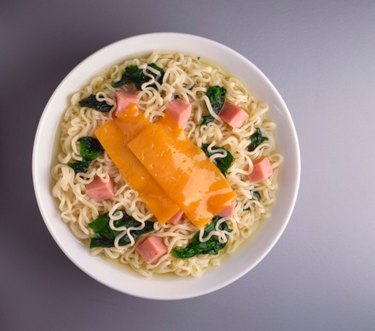
Saimin and ramen are both types of long, thin noodles used in Asian cuisine. While both noodles can be used interchangeably in any number of Asian soups or salads, saimin and ramen are also the names of specific dishes prepared with the noodles and other ingredients. You can buy both types of noodles either fresh or dried in most grocery stores or Asian markets.
Ramen
Video of the Day
Ramen noodles are wheat noodles and are off-white in color. They generally do not contain eggs, and are sold fresh, frozen, dried and in instant forms. The instant forms have been deep-fried and are packaged in a brick shape. This is the popular ramen soup that includes a flavor package and can be cooked in under five minutes. In Japan, ramen is generally made with fresh noodles and a rich meat stock and may contain vegetables. Authentic Japanese ramen is very different from the instant packages sold in the U.S.
Video of the Day
Saimin
Saimin noodles are usually made with wheat flour and eggs. They are sold fresh or dried, but not deep-fried as instant ramen noodles are. The dish called "saimin" is found only in Hawaii, and is even served in Hawaiian fast-food chain restaurants. It is made with saimin, ramen or other types of Asian noodles in a dashi broth with dried cured seafood, barbecued meat, green onions and even Spam.
Culture and History of Ramen
Ramen dishes are considered part of the Japanese culture, but actually originated in China and were introduced to Japan by migrant workers in the early 20th century. They are popular throughout Japan, where they are sold on street corners and in special ramen shops. There are dozens of regional variations of Japanese ramen, and cold ramen soups are served during hot summer months.
Culture and History of Saimin
Saimin comes from the Chinese words "sai" meaning thin and "mein" meaning noodle. It originated in Hawaii during the days of the sugar and pineapple plantations, also in the early 20th century. It was a collaboration among the Chinese, Philippine, Japanese and Hawaiian plantation workers to create a cheap and easy meal while they worked in the fields. It includes ingredients from each of those cultures, and is considered by some to be the state dish of Hawaii.